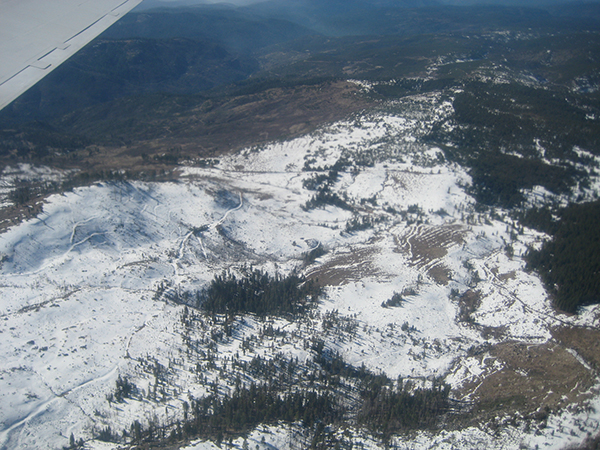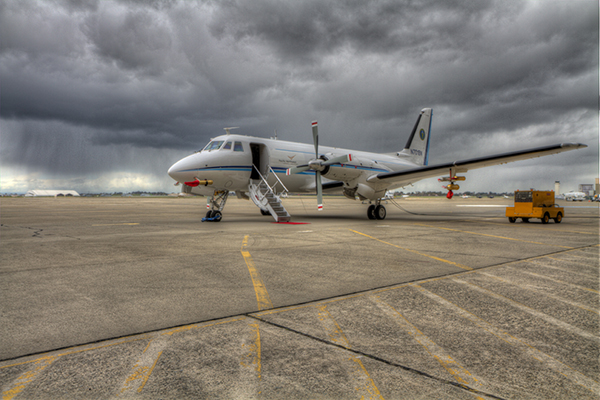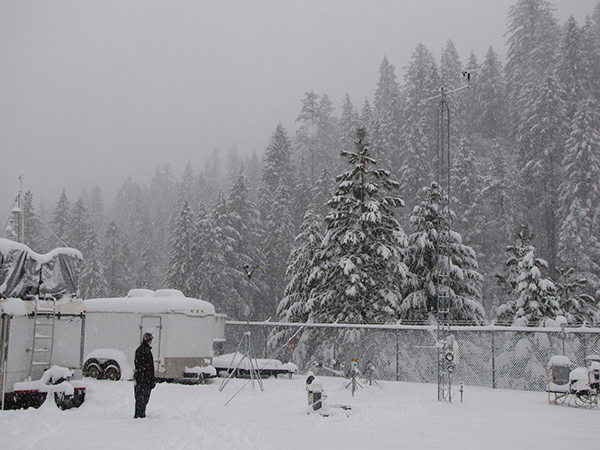
by Sam Lemonick Thursday, February 28, 2013

Researchers flying over the Sierra Nevada during winter storms in 2009, 2010 and 2011 collected data on the chemical composition of particles suspended in the air from a plane and on the ground, and then combined those data with cloud and particle data from satellites. Courtesy of Kimberly Prather

Ready for takeoff. Scientists flew through storms to measure aerosols to determine if and how aerosols affect winter precipitation in California. Courtesy of Kimberly Prather

One of the field sites in the Sierra Nevadas where researchers sampled winter precipitation. Courtesy of Kimberly Prather
What triggers the mountain rain and snow that are vital to California’s water and energy needs? The answer, according to new research, is blowing in the wind: dust and bacteria from as far away as Africa’s Sahara Desert.
Kimberly Prather, an analytical chemist at the University of California at San Diego, and her colleagues set out to study pollution’s effect on precipitation. During winter storms from 2009 to 2011, they collected precipitation samples both on the ground and at altitude while aboard a plane in order to determine the chemical composition of particles suspended in the air. They then combined those data with cloud and particle data from satellites. The goal was to get a clear picture of the complicated processes that cause precipitation in California, especially during winter. Understanding this process is crucial in the state, where tens of millions of people depend on the accumulated snow and ice from winter storms for water and hydroelectricity throughout the year.
Prather and her colleagues found that tiny particles of dust and bacteria from thousands of kilometers away in Africa, the Middle East and Asia — not local pollution — helped kick start winter precipitation. “On the days where there was a lot of snow on the ground, every time, we found that there were these dust and biological particles that were coming across the Pacific,” Prather says.
It’s been known that winds can carry aerosols from continent to continent at high altitudes. The process begins with a stream of moisture-rich air flowing east from the Pacific Ocean — referred to as an atmospheric river — that rises over the Sierra Nevada, cools and forms clouds, Prather says. The droplets in a cloud remain too small to fall to Earth until they freeze and aggregate, she says, but that can’t happen without a trigger, even as the water cools as low as minus 38 degrees Celsius. The dust and bacteria that Prather’s group found arrive in different air masses and can serve as nuclei for ice crystals that then fall to Earth as snow, hail or rain depending on temperatures and other factors, the team reported this week in Science. That’s because it appears that bacterial particles are “the best at nucleating ice,” Prather says: They cause ice formation at higher temperatures — about minus 1 degree Celsius.
The study represents significant progress in understanding how biological aerosols affect rain- and snowfall in the Western U.S., says Ruby Leung, a climate-modeling physicist at the Pacific Northwest National Laboratory. “A lot of people thought that biological aerosols were not that important,” she says.
One of the more interesting findings of the research, Prather says, is that local pollutants seem to have a negative correlation with precipitation in the region. Pollution aerosols and natural aerosols don’t tend to appear together in clouds. That’s because pollutants — soot and other particles from smokestacks and exhaust pipes — rise up into the base of Sierra Nevada clouds while natural aerosols are being delivered to the region at a much higher altitude, probably 5,000 meters above the surface, she says. These two kinds of air movement don’t often happen at the same time, so when clouds are full of pollutant aerosols there is relatively little dust and bacteria and less precipitation forms. Why these two different airflow patterns don’t occur simultaneously is not yet clear.
This study provides the first evidence of dust and bacteria from Africa and the Middle East reaching the Western U.S. year-round, Leung says. Previously, many experts thought that this kind of aerosol movement didn’t happen until spring, when Asian soils thaw. But Prather’s research shows that desert aerosols can help to seed precipitation all winter long.
Learning more about how dust and bacteria particles travel and their effects on cloud formation will help meteorologists predict storms by tracking their movement across the planet, Prather says. This could help California’s state energy agency, a major funder of this research, ensure that its hydroelectric dams have enough water.
© 2008-2021. All rights reserved. Any copying, redistribution or retransmission of any of the contents of this service without the expressed written permission of the American Geosciences Institute is expressly prohibited. Click here for all copyright requests.